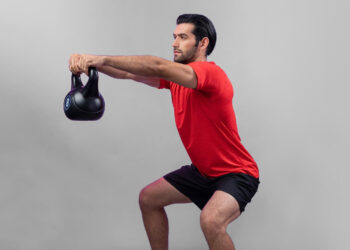Calories Burned Doing Hanging Knee Tucks
Hanging knee tucks are a great way to burn calories and get an intense ab workout at the same time.
In fact, depending on your weight and exercise intensity, you’ll burn about 4.4 calories each minute you do hanging knee tucks, equaling 264 calories each hour.
Calories Burned with Ab Exercises (weight: 170 lbs)
| Exercises | MET | 30 min. | 60 min. |
|---|---|---|---|
| Ab Exercises | 7 | 283 | 567 |
| Abdominal Roll Wheel | 4 | 162 | 324 |
| Bicycle Crunches | 2.9 | 117 | 235 |
| Crunches | 2.8 | 113 | 227 |
| Hanging Knee Tucks | 3.2 | 130 | 259 |
| Reverse Crunches | 3 | 122 | 243 |
| Side Crunches | 2.9 | 177 | 235 |
| Side Plank | 5 | 202 | 405 |
| Burpees | 8 | 324 | 648 |
| Bridges | 6 | 243 | 486 |
How the Calculator Works
Our calculator uses MET values to give you an accurate estimate of how many calories you can expect to burn while doing hanging knee tucks and other similar activities. The higher the MET value, the more calories you will burn.
What is a MET Value?
MET stands for metabolic equivalent of task, and these values give us an estimated expenditure of energy for many different activities, like hanging knee tucks.
A MET value is a ratio between the working metabolic rate and the resting metabolic rate, which is the rate of energy that is used relative to the duration of time spent doing activities such as hanging knee tucks [1].
For example, this means that a MET value of 1 is the same as being at rest, while a MET value of 10 means you’re burning 10 times more calories than being at rest.
Level Up Your Fitness: Join our 💪 strong community in Fitness Volt Newsletter. Get daily inspiration, expert-backed workouts, nutrition tips, the latest in strength sports, and the support you need to reach your goals. Subscribe for free!
It’s also important to know that the number of calories burned depends on other factors including your height, weight, body composition, body fat percentage, and muscle mass.
Pretty much every exercise has a MET value associated with it. For example, there are MET values for exercises like burpees, jumping jacks, and sit-ups.
Most activities come with varying levels of intensity and have different MET values assigned to them. However, hanging knee tucks have a MET value of 3.2 which means they burn over three times as many calories as being at rest.
Formula
The formula that the calculator uses to determine the number of calories burned per minute is (body weight in Kg x MET x 3.5) ÷ 200.
Examples
A person weighing 175 pounds will burn approximately 264 calories per hour from doing hanging knee tucks. This is what the formula for calculating the calories burned will look like for a 175-pound individual at a MET value of 3.2.
- Calories burned (per minute) = (body weight in kg x MET x 3.5) ÷ 200
- Calories burned (per minute) = ( 79.4 x 3.2 x 3.5 ) ÷ 200
- Calories burned (per minute) = 4.4 calories x 60
- Calories burned (per hour) = 264 calories per hour
Read on to find out everything you need to know about hanging knee tucks and how to do them correctly for the most benefit.
How to do Hanging Knee Tucks
Hanging knee tucks are easy to learn but hard to master. Here is a step-by-step guide on how to do this exercise:
- Start by hanging on a pull-up bar. Keep your body straight and use an overhand grip.
- Engage your core as you raise your knees toward your chest.
- Stop when your thighs are parallel to the floor.
- Lower your legs slowly, returning to the starting position.
- Try repeating 10 times (or your target number of reps).
Perfecting the Form
Hanging knee tucks are an exercise that you need to have the proper form if you want to avoid injury and get the most benefits.
Here are our top tips for getting the most out of your hanging knee tucks:
- Keep breathing steadily. You should inhale and exhale constantly when doing this exercise. Make sure that you’re not holding your breath.
- You should engage your core before you raise your knees. Doing so protects your back from injury and works your core more effectively.
- Remember to keep your back straight when doing this exercise. The reason for this is that you want to avoid putting too much pressure on your spine.
- Always make sure that your movements are slow and controlled. You need to resist the temptation to swing your legs to lift your knees higher.
Benefits of Hanging Knee Tucks
Hanging knee tucks offer plenty of benefits for muscle groups in addition to the core. You’ll also find benefits for your overall strength, fitness, and aesthetics.
You’ll find that by doing hanging knee tucks regularly, your other compound lifts will improve as well. You’ll have better stability that is required to maintain proper form and control for lifts like squats, deadlifts, and bench presses.
The hanging knee tuck also supports the lower back and reduces the tendency to arch by strengthening the muscles that oppose the movement. Having a neutral position for your spine is one of the key benefits of executing proper hanging knee tucks.
An added benefit from gripping the bar used to do hanging knee tucks is that your grip strength and forearm strength will improve the longer you hang from the bar. This transfers to exercises like pull-ups and other activities like rock climbing.
If you’re looking for hypertrophy, the hanging knee tuck will allow you to put on size and promote muscular development across the abdominal region.
Common Mistakes
There are several mistakes that you may find yourself making when first starting to learn hanging knee tucks. Luckily, we’ve compiled a list of the most common mistakes beginners make with this exercise.
Swinging your legs
The most common mistake that people make when doing hanging knee tucks is swinging their legs and using their momentum to find the strength to lift up the legs and perform the next rep.
This can be detrimental to your progress in the gym and prevent you from getting the maximum benefit that this exercise provides. Swinging the legs decreases the amount of work your lower body does and reduces the improvements to your strength.
Swinging your legs also disengages your abs and they won’t contract during the movement. This is why a high number of reps is not necessarily good with hanging knee tucks. You need to emphasize the quality over quantity for this exercise.
Arching the back
If you observe others in the gym doing hanging knee tucks, you may find that a lot of them are arching their lower back when they fail to activate the lower abs and glutes.
This results in poor form that looks as if you’re sticking out your stomach and have a visible arch across your spine up to your mid-back. Arching the back also deactivates your abs and forces you to rely on your hip flexors to lift your lower body.
You’ll know if you’re arching your lower back if you feel that you’re straining the top of your thighs and lower back. To avoid this, you should focus on bringing the front of your pelvis to your rib cage and engage your glutes.
If you’re doing the exercise correctly, you’ll feel your abdominal muscles across your stomach working throughout the exercise.
The Bottom Line
Hanging knee tucks may not get as much attention as other ab exercises like crunches, but they can pack a powerful punch and give you some pretty awesome benefits if you’re looking to tone your midsection.
It’s important that you take enough time to properly learn the form for hanging knee tucks, as falling victim to one of the common mistakes people make could lead to injury and stifle your progress in the gym.
Use our hanging knee tuck calculator to get an idea of how many calories you can expect to burn while doing this exercise, and be sure to check out all the other calculators that we have to offer at Fitness Volt!
References:
- Jetté, M., Sidney, K., & Blümchen, G. (1990). Metabolic equivalents (METS) in exercise testing, exercise prescription, and evaluation of functional capacity. Clinical cardiology, 13(8), 555–565. https://doi.org/10.1002/clc.4960130809

















